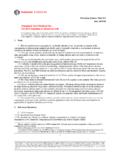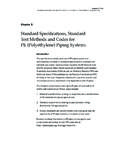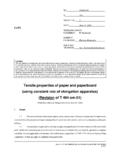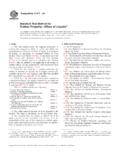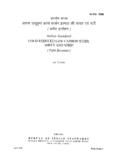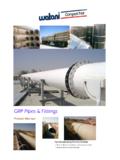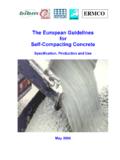Transcription of Standard Test Method for The Determination of …
1 Designation: X XXXX-XXWork Item Number: WK17170 Date: 10/10/08 Standard Test Method for The Determination of Asbestos in Soil1 This Standard is issued under the fixed designation X XXXX; the number immediately following the designation indicates the year of original adoption or, in the case of revision, the year of last revision. A number in parentheses indicates the year of last reapproval. A superscript epsilon ( ) indicates an editorial change since the last revision or reapproval. test Method covers a procedure to: (a) identify asbestos in soil, (b) provide an estimate of the concentration of asbestos in the sampled soil (dried), and (c) optionally to provide a concentration of asbestos reported as the number of asbestos structures per gram of sample. 1 This test Method produces results that may be used for evaluation of sites contaminated by construction, mine and manufacturing wastes, deposits of naturally-occurring asbestos and other sources of interest to the investigator.
2 This test Method describes the gravimetric, sieve, and laboratory procedures for preparing the soil for analysis as well as the identification and quantification of any asbestos Asbestos is identified by techniques using polarized light microscopy (PLM) and transmission electron microscopy (TEM) or both and is based on morphology, optical properties and for TEM selected area electron diffraction (SAED), and energy dispersive X-ray analysis (EDXA). Some information about fiber size may also be determined. The PLM and TEM methods use different definitions and size criteria for fibers and structures. Separate data sets may be This test Method has an analytical sensitivity of < by weight with optional procedures to allow for an analytical sensitivity of by weight. The values stated in Standard International Units (SI) are to be regarded as the Standard . The values given in parentheses are for information Hazard--Asbestos fibers are acknowledged carcinogens.
3 Breathing asbestos fibers can result in disease of the lungs including asbestosis, lung cancer, and mesothelioma. Precautions should be taken to avoid creating and breathing airborne asbestos particles when sampling and analyzing materials suspected of containing asbestos. (Regulatory requirements addressing asbestos are defined by the Environmental Protection Agency (40 CFR Part 61, Subpart M and 40 CFR Part 763, Subpart E) and the Occupational Safety and Health Administration (29 CFR Parts 1910, 1916, and 1926). This Standard does not purport to address all of the safety concerns, if any, associated with its use. It is the responsibility of the user of this Standard to establish appropriate safety and health practices and determine the applicability of regulatory limitations prior to Documents Standards2D 1193 Specification for Reagent WaterD 6281 Standard Test Method for Airborne Asbestos Concentration in Ambient and IndoorAtmospheres as Determined by Transmission Electron Microscopy Direct Transfer (TEM)1 This test Method is under the jurisdiction of ASTM Committee D22 Air Quality and is the direct responsibility of Subcommittee and Analysis of Asbestos.)
4 Current edition approved XXX. XX, XXXX. Published XX For referenced ASTM standards , visit the ASTM website, , or contact ASTM Customer Service at For Annual Book of ASTM standards volume information, refer to the Standard 's Document Summary page on the ASTM document is not an ASTM Standard ; it is under consideration within an ASTM technical committee but has not received all approvals required to become an ASTM Standard . You agree not to reproduce or circulate or quote, in whole or in part, this document outside of ASTM Committee/Society activities, or submit it to any other organization or standards bodies (whether national, international, or other) except with the approval of the Chairman of the Committee having jurisdiction and the written authorization of the President of the Society. If you do not agree with these conditions please immediately destroy all copies of the document. Copyright ASTM International, 100 Barr Harbor Drive, West Conshohocken, PA 19428.
5 All Rights Reserved. X XXXXD 3670 Guide for Determination of Precision and Bias of methods of Committee D22E 11 Specification for Wire Cloth and Sieves for Testing OSHA Standards3 OSHA, 29 CFR Part 1910 Occupational Safety and Health standards OSHA, 29 CFR Part 1926 Safety and Health Regulations for EPA Standards4 EPA 600/R-93 116 Method for the Determination of Asbestos in Bulk Building MaterialsEPA 600/M4-82-020 Interim Method for the Determination of Asbestos in Bulk Insulation SamplesUSEPA 40 CFR Part 61, Subpart M National Emission Standard for AsbestosUSEPA 40 CFR Part 763, Subpart E Asbestos-Containing Materials in School ISO Standards5 ISO (the International Organization for Standardization), Ambient Air - Determination of Asbestos Fibers Direct Transfer Transmission Electron Microscopy Method , ISO 10312:1995, (1st Ed. 1995-05-01). Definitions: asbestiform type of fibrous habit in which the fibers are separable into thinner fibers and ultimately intofibrils.
6 Discussion--This habit accounts for greater flexibility and higher tensile strength than other habits of the same mineral. For more information on asbestiform mineralogy, see Refs (1), (2), (3) and (9). asbestos collective term that describes a group of naturally occurring, inorganic, highly fibrous, silicate-dominated minerals that are easily separated into long, thin, flexible fibers when crushed or processed. Discussion--Included in the definition are the asbestiform varieties of: serpentine (chrysotile), riebeckite (crocidolite), grunerite (amosite), anthophyllite (anthophyllite asbestos), tremolite (tremolite asbestos), and actinolite (actinolite asbestos). The amphibole mineral compositions are defined according to nomenclature of the International Mineralogical Association (3) and (9). AsbestosChemical Abstract Service asbestos77536-67-5 Tremolite asbestos77536-68-6 Actinolite fibril, n single fiber that cannot be separated into smaller components without losing its fibrous properties or appearance.
7 Aspect ratio ratio of the length of a fibrous particle to its average bundle USE ASTM 6281 Set of definitions -----tructure composed of three or more fibers in a parallel arrangement with the fibers closer than one fiber diameter to each other. cluster structure with fibers in a random arrangement such that all fibers are intermixed and no single fiber is isolated from the group; groupings of fibers shall have more than two points touching. chunks materials that are of an amount and size that remain in the ~19mm ( cm) sieve after fiber(TEM) structure having a minimum length of , an aspect ratio of 3:1 or greater, and substantially parallel sides (4).3 Available from the Occupational Safety and Health Administation, 200 Constitution Ave., , Wahsington, DC Available from the Environmental Protection Agency, Ariel Rios Bldg., 1200 Pennsylvania Ave., , Washington, DC Available from the International Organization for Standardization (ISO), 1, ch.
8 De la Voie-Creuse, Case postale 56, CH-1211 Geneva 20, Switzerland2 X XXXX fibrous (PLM) of a mineral composed of parallel, radiating, or interlaced aggregates of fibers, from which the fibers may or may not be separable, that is, the crystalline aggregate may be referred to as fibrous even if it is not composed of separable fibers, but has that distinct appearance. Discussion--The term fibrous is used in a general mineralogical way to describe aggregates of grains that crystallize in a needle-like habit and appear to be composed of fibers. Fibrous has a much more general meaning than asbestos. While it is correct that all asbestos minerals can have a fibrous habit not all minerals having fibrous habits are matrix structure in which one or more fibers, or fiber bundles that are touching, are attached to or partially concealed by a single particle or connected group of nonfibrous particles. The exposed fiber shall meet the fiber definition (see ).
9 Soil (reference ASTM definition D2216-98/D653-07- maximum size ~19mm) loose top layer of the earth's surface consists of rock and mineral particles mixed with decayed organic matter. estimated weight percent defined as the visual area estimation of asbestos in a sieved fraction multiplied by the weight of the fraction analyzed. structures (TEM) term that is used to categorize all the types of asbestos particles that are recorded during the analysis (such as fibers, bundles, clusters, and matrices). visual area estimate (VAE) a quantitative estimate of the amount of asbestos present most readily obtained by visual comparison of the bulk sample and slide preparations to other slide preparations and bulk samples with known amounts of asbestos present in them . Given that soils are typically heterogeneous sieving the soil helps to achieve similar particle size and texture for subsequent microscopic evaluation and estimation.
10 Of Test soil sample is dried and sieved with sieves arranged from top to bottom; >19mm, >2-mm- 19mm (coarse fraction), >106- m to <2-mm (medium fraction), and <106- m (fine fraction). Weights for each fraction are measured and recorded. During analysis the >19mm fraction is analyzed using stereomicroscopy and PLM for large chunks and reported separately. The result is not included in the final result of the other three sieves. Any building material debris collected along with the soil sample is also analyzed and reported coarse fraction (>2-mm to < 19mm), medium fraction (>106- m to <2-mm) fine fraction (<106 m) are all analyzed by PLM calibrated visual area estimation (VAE). Results for the PLM analyses are expressed in estimated weight percent. Further analysis of the fine fraction may be performed by TEM to provide size data and concentration of asbestos reported as the number of asbestos structures per gram of sample and or estimated weight rules -- A progressive analysis approach is utilized beginning with the coarsest sieved fraction.
